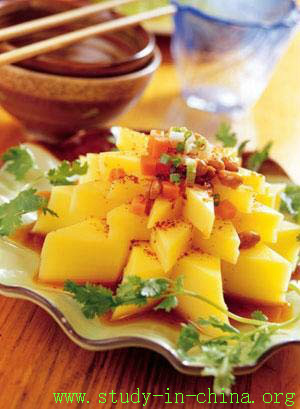| Home > China Feature |
Everyday Eating Customs in China
Chinese cuisine culture is deep rooted in China's history. There are so many “whys” that you may find so interesting: Why is a fish never turned over? Why do tea-drinkers surreptitiously tap tables? Why are Chinese dinner tables round and how will you know who is the guest of honor?

The whole meal will be more enjoyable if you knows a little of the ancient traditions and beliefs that place the meal in a 5,000-year-old culinary heritage.
As a visitor or guest in either a Chinese home or restaurant you will find that table manners are essential and the distinctive courtesies displayed will invariably add to the enjoyment of your meals and keep you in high spirits!
1. Though customs and the kinds of food eaten vary according to region, it is most common for Chinese families to gather for three meals a day.
2. An individual place setting for an everyday meal includes a bowl of Fan (rice), a pair of chopsticks, a flat-bottomed soup-spoon, and a saucer. Instead of a napkin, a hot towel is often provided at the start as well as the end of the meal for the diner to wipe his hands and mouth.
3. The real difference is that in the West, you have your own plate of food, while in China all the dishes will put on the table for everyone’s share. The meat and vegetable dishes are laid out all at once in the center of the table, and the diners eat directly from the communal plates using their chopsticks. Soup is also eaten from the common bowl. Rather than for serving oneself a separate portion, the saucer is used for bones and shells or as a place to rest a bite taken from a communal plate when it is too large to eat all at once.
4. It is perfectly acceptable to reach across the table to take a morsel from a far-away dish. To facilitate access to all the dishes, Chinese dining tables are more likely to be square or round, rather than elongated like their western counterparts.
5. Maybe one of the things that will surprise a Western visitor most is that some of the Chinese hosts would like to put food into the plates of their guests. Usually in formal dinners, there are always “public” chopsticks and spoons for this purpose, but some hosts may still use their own chopsticks. This is a token of genuine friendship and politeness. It is polite to eat the food. If you don’t like to eat it, please just leave the food in the plate.
6. Eating usually begins in order of seniority, with each diner taking the cue to start from his or her immediate superior.
7. In order to cool the soup a bit and to better diffuse the flavor in the mouth, soup is eaten by sipping from the spoon while breathing in. This method, of course, produces the slurping noise that is taboo in the West.
8. Rice, or Fan in Chinese, is the staple food. To eat Fan, a diner raises the bowl to her lips and pushes the grains into her mouth with chopsticks. This is the easiest way to eat it and shows proper enjoyment. The diner must finish the entire bowl of rice, otherwise it is considered bad manners -- a lack of respect for the labor required to produce it.
9. People in China tend to over-order food, especially at banquets or get-togethers, for they will find it embarrassing if all the food is consumed or not enough.
Art
 more
moreChina Beijing International Diet ...
Recently, The hit CCTV documentary, A Bite of China, shown at 10:40 ...

Exhibition of Ancient Chinese Jad...
At least 8,000 years ago, Chinese ancestors discovered a beautiful...

Longmen Grottoes
The Longmen Grottoes, located near Luoyang, Henan Province, are a tr...

Custom
 more
moreWeb Dictionary
Martial Arts
Tai Chi Master Class Held in Moscow
MOSCOW, June 15, 2016 (Xinhua) -- Students learn from Shaolin ...
Celebriting 70 years' efforts in restoring Mogao...
Work is being carried out at the restoration site of cave No 98 a...
Hong Kong Children's Symphony performs in Seattle
Under the theme of Tribute to the Golden Age, a concert featuring a ...





 print
print  email
email  Favorite
Favorite  Transtlate
Transtlate 








